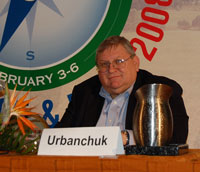 The science of ethanol can now be taught in the classroom in an informative and entertaining way with the Ethanol Promotion and Information Council’s (EPIC) new educational fun pack and student contests.
The science of ethanol can now be taught in the classroom in an informative and entertaining way with the Ethanol Promotion and Information Council’s (EPIC) new educational fun pack and student contests.
The pack includes six different units for teachers – English, geography, science, math, vocabulary, and social studies. It also includes lots of fun stuff like the “How Ethanol is Made” video, several in-class activities including a crossword puzzle, word find and quiz, wristbands, environmental clings, children’s books, t-shirts and five Team Ethanol IndyCar® Series die-cast cars.
In addition, EPIC is sponsoring ethanol essay, podcast and coloring contests for students. Teachers who teach 4th through 6th grade can go online to www.drivingethanol.org/classroom to order their free educational materials and find out about the contests.




 Last month, the young company made a splash at the North American international Auto Show in Detroit where a strategic partnership with General Motors was announced.
Last month, the young company made a splash at the North American international Auto Show in Detroit where a strategic partnership with General Motors was announced. According to Dave Vander Griend, president and CEO of ICM Coskata’s thermal biomass conversion process offers promising technology.
According to Dave Vander Griend, president and CEO of ICM Coskata’s thermal biomass conversion process offers promising technology. “The bottom line is that the energy balance of biodiesel has definitely improved in the last decade,” says University of Idaho Department Head of Biological and Agricultural Engineering Jon Van Gerpen, who credits Assistant Professor Dev Shrestha and graduate student Anup Pradhan for their work on the study. “The increase in soybean yields and a decrease in herbicide use greatly contributed to the increased energy balance. Meanwhile, energy used for crushing soybeans is significantly lower than what was reported in the NREL study.”
“The bottom line is that the energy balance of biodiesel has definitely improved in the last decade,” says University of Idaho Department Head of Biological and Agricultural Engineering Jon Van Gerpen, who credits Assistant Professor Dev Shrestha and graduate student Anup Pradhan for their work on the study. “The increase in soybean yields and a decrease in herbicide use greatly contributed to the increased energy balance. Meanwhile, energy used for crushing soybeans is significantly lower than what was reported in the NREL study.” One of the most popular sessions at this week’s
One of the most popular sessions at this week’s  He says that food items where corn and soybeans play a major role only account about 25 percent of the food basket.
He says that food items where corn and soybeans play a major role only account about 25 percent of the food basket. The president of the
The president of the  The three-year study will focus on land use in North Dakota, South Dakota, Nebraska, western Minnesota and northern Iowa. “If you look at one of the maps by the Renewable Fuels Association, the hotspot of the activity is in this area,” said professor Geoff Henebry, a senior scientist in the Geographic Information Science Center of Excellence (GIScCE) at SDSU.
The three-year study will focus on land use in North Dakota, South Dakota, Nebraska, western Minnesota and northern Iowa. “If you look at one of the maps by the Renewable Fuels Association, the hotspot of the activity is in this area,” said professor Geoff Henebry, a senior scientist in the Geographic Information Science Center of Excellence (GIScCE) at SDSU. According to the
According to the  Keep in mind this is only the fifth annual conference for this industry and about 4,000 people are at the event with almost 400 exhibitors. Many of the booths are showcasing new technology for the industry – while others, like New Holland, are focusing on the fun stuff.
Keep in mind this is only the fifth annual conference for this industry and about 4,000 people are at the event with almost 400 exhibitors. Many of the booths are showcasing new technology for the industry – while others, like New Holland, are focusing on the fun stuff.